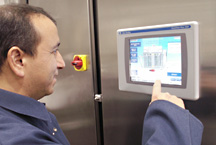Tech Flash Vol 7, No. 12 -- Food Engineering's E-Newsletter

Processor cuts water usage by 80 percent
The processor implemented new water reclamation systems in which water is captured, stored and cooled in a new, high-tech closed loop system that more rapidly cools food at the end of the cooking cycle during the retort process. This efficient system increases retort capacity, and in addition, food quality benefits from the shorter cycle times of the process.
Wornick began the multi-million dollar capital project, as part of its overall sustainability program, to achieve more efficient utilization of water and greater community responsibility. One million gallons of water per day are now recycled and treated through the new chilling process inside the facility. By using less water on a daily basis, Wornick is achieving a cost savings while helping the Metropolitan Sewer District of Cincinnati (MSD) free up its sewer line capacity.
“Wornick is highly committed to sustainability. We have been one of the largest industrial users of water in Blue Ash,” says Michael Hyche, vice president of operations at Wornick Foods. “Now, through the recycling of our process water and new chilling capacity, we have reduced the amount of water we purchase in addition to the amount we discharge into MSD sewers. This has resulted in a significant annual cost savings for the company.
“We are continually evaluating new technology opportunities to increase our efficiency while decreasing our impact on the environment,” adds Hyche.
Processors seek total processing/packaging solutions
“A total systems approach allows the processing and packaging teams to better understand what product or packaging changes can feasibly run on the line,” adds Egan. “This is especially important during new product introductions and package redesigns. The teams can also coordinate equipment purchases to generate the best results in their efforts to increase sustainability, efficiency or automation.”
PMMI sees specific trends in food and beverage processing, that are having an impact on manufacturing equipment and systems across the line. Advancing automation and increasing energy-efficiency continue to be priorities as manufacturers look to make their operations more sustainable. Systems that can run packaging help minimize product waste in both processing and packaging lines, and help manufacturers reduce their carbon footprint.
Product safety remains a top priority as well, says Egan. Equipment or systems offering high rates of detection will become increasingly important additions to the manufacturing operation. With a unified approach to processing and packaging line improvements, manufacturers can evaluate and monitor product safety from the start of production and through the stages of packaging distribution.
To address this need, The Food Safety Summit Resource Center will debut at PACK EXPO Las Vegas 2011 (
Enhanced flexibility is also a major trend that affects the whole operation. Manufacturers must be able to quickly accommodate changes to a product line. Equipment that’s easier to adjust will boost productivity and efficiency. Communication between the processing and packaging teams helps assure any new machinery added to either line works smoothly with current and future devices. Having machinery that can be adjusted or replaced at the same time helps to minimize downtime and keep the pace of production.
Post-show research conducted by PMMI first prompted the integration of processing at PACK EXPO International 2010, with the majority of past attendee survey respondents indicating they came to see packaging and processing suppliers. The Processing Zone highlights the latest processing technologies for a range of market sectors including food, beverage, baking and snack, meat, dairy and produce.
For more information on PACK EXPO Las Vegas, visit www.packexpo.com.
Simplifying secondary packaging reduces fossil-fuel demand
The redesign project tapped into strapping technology already used with success in other sectors, but it required a completely new packaging design for PET containers called LitePac and a new packer called Evolite.
According to Krones, users will benefit from cost economies compared to shrink-films, with some estimates exceeding 50 percent. This new packaging design addresses market trends for secondary packaging of PET containers with regard to eco-compatibility, resource-economy, reduced energy consumption and cost savings.
The Evolite packer features a container infeed module and a container strapping module. In the infeed module, the containers are divided into two continuous lane flows. Four strapping units then create the LitePac packs in the container strapping module.
For more information, visit Krones on the Web.Automation News

Manufacturing in the digital age: All aboard!
Advanced manufacturing technology is rapidly transforming the global competitive landscape, according to two of the SMLC leaders: Jim Davis, vice provost IT, chief technology officer for the University of California at Los Angeles, and Sujeet Chand, chief technology officer for Rockwell Automation. The companies-and nations-that act now to seize its promise will thrive in the 21st century. Those who fail to fully engage in smart manufacturing will rapidly fall behind, according to the two SMLC leaders.
While
The SMLC and the National Center for Manufacturing Sciences (NCMS) have formed a working partnership to build a National Smart Manufacturing Ecosystem. It is an iPhone-like “App Store” for industrial modeling and simulation applications and their rapid application. NCMS is also providing its Predictive Innovation Center (PIC) strategy to link nationally to other modeling and simulation centers while extending its outreach to small and medium-sized enterprises.
“There are nearly 300,000 small and medium-sized manufacturers in the
Along with representatives from 50 leading manufacturers, technology suppliers, universities and other organizations, Rockwell Automation, UCLA and the
- Industrial community modeling and simulation platforms for smart manufacturing
- Affordable industrial data collection and management systems
- Enterprise-wide integration: business systems, manufacturing plants and suppliers
- Education and job training skills needed for smart manufacturing design, operation and maintenance.
“We want to clearly emphasize that no single company or industry segment can achieve this transformation alone, and time is of the essence,” says SMLC Co-founder Tom Edgar, a chemical engineering professor with UT-Austin.
Smart manufacturing will provide new ways to extend the essential productivity gains that have kept many
New equipment lets chef prepare high-quality RTE meals
“We are going to see a tremendous amount of growth in the RTE marketplace,” says Walter Sommers, president of Ruprecht Company, a
The advanced cooking equipment available to processors today is more compact, flexible and affordable than what was available to the RTE segment in the past. Systems like the Unitherm mini flame griller, rapid flow oven and mini-spiral oven that Ruprecht purchased replaced less reliable batch cooking processes, which are harder to control and often produce meals that are inconsistent in quality and taste.
Ruprecht, which produces chicken, beef, pork, lamb and a limited selection of seafood entrées, fully cooks about 30 percent of its products. These heat-and-serve items are prepared according to either customer specifications or those of its in-house chef.
“Our chef is using the equipment to process products that meet the same expectations as you would have if you were cooking at home on a barbeque,” says Sommers.
Rather than use somewhat unpredictable batch cooking methods where equipment has few controls, Ruprecht incorporated continuous processes into its production, using Unitherm’s automated flame grills and spiral ovens to control the production of meals and ensure they are always consistent in quality.
Built-in controls for variables (e.g., temperature, time, humidity and fan speed) allow the processor to maintain very tight tolerances to improve consistency. Touch-screen controls allow the processor to alter equipment settings if the operators choose, thereby creating new recipes that are stored for future use. The controls enable processors to further develop their current products or develop new ones.
Spiral ovens let chefs achieve exactly what they want in rotisserie, baking and basting. With a spiral oven, a built-in basting effect can be incorporated. For example, as chicken spirals upward in the oven, the juice from each piece of meat falls on the one below, enhancing both color and texture. Spiral ovens enable steaming, roasting, broiling, baking and post-pasteurizing, and can be coupled with a chiller and loading systems to suit users’ needs with limited space.
Flame grills can reach very high temperatures in short periods of time. The flame temperature of the grill is much higher than that of restaurant-type grilling equipment. It can be set as high as 1,500°F, and can be throttled back to get the desired finishing effect. In addition to throughput, this equipment has much more thermal capacity than restaurant equipment-i.e., heat energy delivered to the product.
“We produce millions of pounds of fully cooked food annually,” says Sommers. “With the new continuous production equipment we’ve recently installed, we are nowhere near exceeding their capacities.”
For information, David Howard, Unitherm Food Systems, 918-367-0197; email; or visit the Unitherm website.Food Safety News

Rapid detection methods for common foodborne illnesses
For processors that must quarantine products until assay results are known, a shorter results time means products quickly enter the supply chain, thus having a longer shelf life, occupying less warehouse space and saving money.
Bailey, in an exclusive FE interview (PDF), said today’s rapid detection methods are much faster than the four to seven days normally required for cultured tests 20 or more years ago. “Now we’re moving into generations of next-day (24-hr) tests, with a few selected cases, primarily for E. coli O157:H7 and maybe some Salmonella in raw meat products in an eight- to 16-hr. range,” says Bailey. For most food products, the Salmonella test requires 16-18 hrs. of incubation, whereas E. coli can run 8-10 hrs., depending on sample size, says Bailey. Bailey’s company has just released a rapid test for Salmonella, which uses bacteriophage technology to detect the Salmonella. A rapid test of E. coli O157:H7 has been available for a year or so.
There has been much discussion on whether the non-shiga toxin E. Coli (STEC) serotypes are as dangerous as O157:H7. “Unfortunately, the non-O157s don’t have the same phenotypic trait. They look like every other run-of-the-mill E. coli on earth, which is about the most common bacteria there is,” says Bailey. “So being able to pull these non-STECs out of the rest of the E. coli population in a sample is much more problematic than finding O157. The non-STECs are only important if they’re present and they possess certain pathogenic virulence factors.”
So the question is an economic one. Typically, 90 percent of E. coli cases in the

US needs to get proactive on E. coli O104:H4
Coming on the heels of an April 2011 E. coli O111 outbreak in
Assays for E. coli O104:H4 may not be as widely available, primarily because until now, it was not an issue in the
“The tragedies in
In an exclusive FE interview, Marler said, “USDA considers E. coli O157:H7 as an adulterant, but it doesn’t consider the other non-O157s that cause human illness as adulterants. The FDA doesn’t make this differentiation between adulterants and non-adulterants. It simply states you can’t sell food that is contaminated with a pathogen.”
According to Marler, he spent $500,000 of his own money in 2010 to fund a test conducted by IEH Laboratories to check random grocery store hamburger samples for non-O157 E. coli. In the study, the results showed the presence of both E. coli O111 and O104 strains.
Marler told FE that calling any E. coli an adulterant prompts processors to do the testing. “That’s what in my view has changed the dynamic in the meat industry-by requiring the testing [for O157:H7], the [meat processors] have done the testing, and the numbers of E. coli cases linked to meat have been dropping dramatically for years.”
Marler says Costco already tests for non-O157s, and some processors in the leafy-green industry are also doing the testing. The reality is, says Marler, there are already processors doing the testing, and to get the rest of them to follow the protocols may take drastic measures.
While it obviously costs more to do the appropriate testing while holding product in quarantine, the costs are certainly much less to the processor than sustaining an outbreak, says Marler. Consider it an insurance policy against losing a brand and all its associated business.
While processors are making the effort to provide safe food, consumers need to be aware that careful preparation and proper storage before and after cooking go a long way to reduce bacteria counts. In addition, cooking to a temperature of 160°F will kill most bacteria, further reducing the possibility of foodborne illness. Health Canada, FDA and USDA provide helpful hints to minimize the possibility of getting sick from meat and other foods that may have bacteria on it when purchased.Looking for a reprint of this article?
From high-res PDFs to custom plaques, order your copy today!




